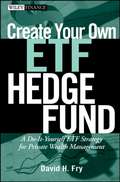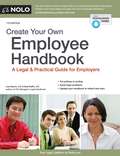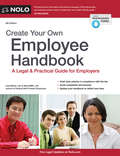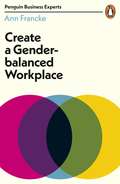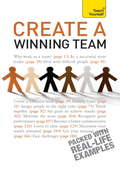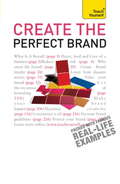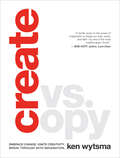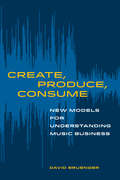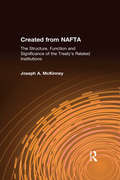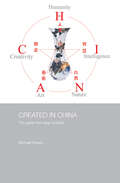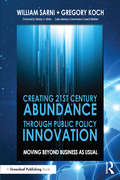- Table View
- List View
Create Uniqueness: How to Turn a Passion Into a Business
by Riccardo PozzoliCreate your dream job by turning your passion into a profitable business. The business world has completely changed. The old routes to building a successful organization have been entirely revolutionized. In a world which is being transformed with a speed that was unthinkable barely a generation ago, the doors have been thrown wide open to serial entrepreneurs, digital innovators and career reinventors. In Create Uniqueness, Riccardo Pozzoli, one of Italy's most successful entrepreneurs, and co-founder of the fashion phenomena The Blonde Salad, shares his story about creating a thriving business and building rewarding work environments. Create Uniqueness is a passionate yet practical guide to identifying a business idea, embracing new ways of working, thinking unusually and building a great company without losing sense of your original idea.
Create Winning Marketing in a Silo World
by David AakerOrganizations need brilliant, break-out-of-the-clutter marketing programs directed at priority markets, especially in these days of media fragmentation. Great marketing is not only cost effective, but will bring silos together. The challenge is how to rise above good to superior in silo markets while creating synergy and leveraging the scope of the organization. This chapter looks at ways of making silos assets instead of hindrances in creating outstanding cross-silo marketing.
Create Your Bright Ideas: Read, Journal, and Color Your Way to the Future You Imagine
by Jess EkstromThis interactive book for energetic, creatively minded 8- to 12-year-olds from entrepreneur Jess Ekstrom uses inspiring stories, journaling prompts, coloring pages, and creative ideas to show kids that if they want something to be different in the world, they can do something about it today! Water the seeds of creativity in your child through this engaging book about having a positive growth mind-set. In Create Your Bright Ideas, Jess motivates kids to be creators and ambitious doers who know they are never too young to change the world. Create Your Bright Ideas helps kids discover their passions by offeringjournaling prompts to bring out your child's bright ideas;personal stories about entrepreneurship and perseverance;practical advice for discovering and using their unique gifts; andmotivational quotes paired with beautiful coloring pages from illustrator Nadia Fisher that can be cut out of the book for easy display.Jess never predicted that her time selling cookies and lemonade as a kid was foreshadowing founding her company Headbands of Hope, which helps millions of kids with illnesses. It wasn't always smooth sailing, but each obstacle she faced put her on an unexpected path of inspiration, helping her discover the amazing things she could become and do, like starting multiple businesses, writing a book, and helping millions of people feel more confident in their story. Now Jess shows kids how to channel their own energy and unique interests to create something meaningful. With inspiration from Jess's bestselling book Chasing the Bright Side, this jump-right-in guide created just for kids and tweens is a great gift forChristmas and birthdays;elementary- and middle-school graduations; andyoung world changers who want to do something lasting but don't know where to start.Create Your Bright Ideas is a perfect size to fit in a backpack, ready to be pulled out whenever inspiration strikes--during car rides, while waiting for the bus, for reading time at school, or right before bed. A powerful and fun reminder that many CEOs and nonprofit leaders started their careers with a lemonade stand, Create Your Bright Ideas takes kids on an exciting journey of purpose, self-discovery, and bold action.
Create Your Own ETF Hedge Fund
by David FryMany investors are intrigued by the profit potential of today's hedge funds, but most feel like they're on the outside looking in, due to the high investment requirements and complexity of these vehicles. Create Your Own ETF Hedge Fund allows you to break down these barriers and effectively operate within this environment. By focusing on the essential approaches of global macro long/short and aggressive growth, this book will help you create a fund that can take advantage of both bullish and bearish conditions across the globe.
Create Your Own Employee Handbook
by Lisa Guerin Amy DelpoCreate a handbook for employees, spelling out your company's benefits, policies and procedures using this practical legal guide Every company, no matter how big or small, needs to provide workers with an employee handbook. Create Your Own Employee Handbook gives you the information and policies all managers, HR professionals and business owners need to create their own reader friendly guide, no matter what state you live in. Each chapter covers a different topic, including: . at will employment . hiring . pay and payroll . workdays and hours . performance evaluations . benefits . discrimination and harassment . complaints and investigations . leave . health and safety . substance abuse . privacy in the workplace . discipline You'll get the lowdown on the legal and practical considerations that apply to each topic in your state, plus sample policies that you can use as is or tailor to meet your needs. You can even cut and paste the language you need to complete your own handbook instantly. This edition is completely updated to reflect recent changes to federal and state law, and covers emerging workplace issues such as healthcare reform law and social networking policies. Download forms for book at nolo.com.
Create Your Own Employee Handbook: A Legal & Practical Guide for Employers
by Lisa Guerin Amy DelpoMake—or update—your employee handbook today with this user-friendly guide! Every company should have an employee handbook to communicate with employees, manage workers effectively, ensure consistent treatment across the organization, and protect itself from lawsuits. But creating a handbook from scratch can be daunting—and hiring a lawyer to draft one can easily cost thousands of dollars. That where Create Your Own Employee Handbook can help. It provides everything managers or HR professionals need to create an effective handbook—or update an existing one—all in plain English. Inside, you’ll find up to date legal information, practical suggestions, and policy language on: wages and hours at-will employment time off discrimination and harassment email, social media, mobile devices, and other workplace technology drugs and alcohol complaints and investigations workplace privacy, and much more. The 8th edition is completely updated to include state law changes affecting employer policies, such as meal and rest breaks; minimum wage laws (including rules for restaurant servers and other employees who receive cash tips); smoking in the workplace; drug and alcohol testing; discrimination; jury duty; family and medical leave; and much more. The 8th edition also covers the latest rules and practices for workplace technology (including employee posts on personal or business social media sites and use of employee-owned smart phones for work).
Create Your Own Online Store in a Weekend
by Alannah MooreThe advantages of selling your products online are many--low overhead, global markets, twenty-four-hour shopping--but perhaps most important is the level playing field offered by the internet. With a distinctive product and professional-looking website, you stand as much of a chance at success as anyone, even if others have more money to invest. In Create Your Own Online Store in a Weekend, Alannah Moore guides entrepreneurs through the process of setting up an online business and creating a website that fits both their products and their budget. This accessible primer provides detailed information on how to set up and provide content for your site as well as the right storefront and payment solutions. Moore addresses all aspects of running an online business, including marketing, order management, and boosting sales. Whether you are selling goods, services, or downloadable files, this guide will help you find the e-commerce solution that's right for you.
Create Your Profitable Trading Plan in 5 Steps
by Álvaro CidMany people would like to be able to invest in the stock market and earn money to the point of living completely from it. But they have a small problem with it: they don't know how to do it. Some of these people have even begun to invest in the stock market with poor results. This is the point at which most leave and consider that investing is very risky for everyone. Sadly, most will not achieve profitability in the market they expected. This guide will help you create your own trading method or plan. I have designed the steps after years of trial and error in the market and in my investment methodology, in this way you can achieve the positive results you want in the market if you follow these simple steps. You can create a Trading plan with this method if: You are an experienced trader who knows rules of entry and exit of the market and wanted to include it in a solid and profitable method. You are a novice trader who is starting and who needs to know the right steps to take from the first moment. You have the desire to make money in the market professionally.
Create Your Yes!: When You Keep Hearing NO: A 12-Step Strategy for Success (Ignite Reads #0)
by Angela Marie HutchinsonAre you tired of hearing "No"? Then create your "Yes!" When you are faced with rejection, do you cringe or thrive? While it may seem that we are out of options when we try something and fail, there is almost a way to make your dreams a reality — in the face of ANY adversary! Angela Marie Hutchinson has a fairly simple motto: dreams don't happen, dreams are made. Rather than admit defeat, Angela herself made her dreams of making a movie a reality by pushing forward despite each "no", "pass", and negative thought that came her way! Using her 12—step approach, those dreams you keep hearing "no" on — those plans that never seem to come to fruition — can finally be realized.
Create a Culture of Learning: Develop the Right Negotiation Training Environment
by Lawrence Susskind Hallam MoviusCreating a culture of continuous learning and feedback is essential to an organization's negotiation success. This chapter outlines the steps and resources that organizations ought to pursue and mobilize to create a world-class negotiating organization. It describes not only the kinds of training that are likely to be successful in changing knowledge and behavior on the job, but also the additional moves organizations can make to increase their return on investment and promote long-term continuous improvement. This chapter was originally published as chapter 4 of "Built to Win: Creating a World-Class Negotiating Organization."
Create a Gender-Balanced Workplace (Penguin Business Experts Series)
by Ann FranckeEquality at work expert Ann Francke reveals how to understand and tackle the damaging consequences of gender imbalance in the workplaceGender balance is first and foremost a business issue. McKinsey estimates we could add 28 trillion to global GDP if we achieved gender equality everywhere - that is more than the GDPs of the US and China combined. But it's so much more than that. Gender balance is one of the best levers we can pull to build better managers and leaders at every level, improve team performance and create better cultures where everyone can thrive.In the Penguin Experts: Create a Gender-Balanced Workplace, Ann Francke, the CEO of the Chartered Management Institute (CMI), introduces her solution to combating the problems at the heart of the continued imbalance and offers clear, actionable strategies for making a positive change in your organisation.
Create a Winning Team: A practical guide to successful team leadership (Teach Yourself)
by Kevin BenfieldAs a team leader, do you believe you can make a real difference to the performance of your team? If you do, Create a Winning Team will help you do just that. <P><P>This book is a practical and commonsense guide to successful team working. It focuses on the skills that team leaders need to develop to work together effectively - unlike most books about team work, which focus on team building events and games , not the practical day to day challenges of getting great results. With a straightforward, down to earth, no nonsense style avoiding unnecessary jargon and using concrete examples and case studies from young, high performing junior managers working in an international environment, the author covers the often practical actions a team leader can do that really make a difference and which you're unlikely to learn on a leadership course, like pitching in now and again and making people tea! <P>The content is built around a logical structure consisting of a set of questions e.g. What do teams do? How will your team succeed? How do you create a balanced team? The chapter headings themselves tell a clear story and stimulate the reader to continue.
Create and Deliver a Killer Product Demo: Tips And Tricks To Wow Your Customers
by Oscar SantolallaCreate great product demos and sell more of your product with the strategies and inspiration in this book. Insightful interviews are presented with professionals who are giving killer product demos in several types of businesses today. The strategies taught in this book are based on the analysis of product demos that made history and brought millions to their companies (Apple, Intel, Microsoft, Tesla, and more).Every day thousands of companies give demos to sell their products. In pre-sales for enterprise software a bad demo can make your product look too complex to the point where decision makers won't buy it. In Software-as-a-Service (SaaS) you need to quickly convert signups into active and paying users. At a product launch event you want a perfect demo that is both persuasive and memorable. Remember Steve Jobs?What You'll LearnApply a simple step-by-step method to create effective product demonstrationsKnow the 5 steps to create a wow momentStudy the first exhaustive analysis of product demos that made history: Douglas Engelbart’s Mother of All Demos; Steve Job’s Macintosh, iPod, and iPhone; and many moreAvoid common mistakes and maximize your presence as a technical presenterAlign your demo with your sales process in enterprise software, Software-as-a-Service (SaaS), mobile apps, etc.Be aware of trends in technology for product demosWho This Book Is ForStartup entrepreneurs, sales engineers, executive or sales representatives, and other professionals
Create the Perfect Brand: A practical guide to branding your business, from creation and vision to protection and delivery
by Julia Hitchens Paul HitchensDo you see branding as the key to the success of your business but aren't sure where to start? This book, written by enthusiastic experts, will help you to maximise your brand, even in a downturn. All aspects of branding are covered including brand creation and protection. Fascinating case studies of famous brands, including the disaster stories, nail their advice in the real world.All aspects of branding are covered including: - what is a brand and why it is heart, soul and core of a business - brands in a recession, including the success stories - methods to value a brand - brand focus - brand creation and structure - brand audience and brand vision -importance of creativity - brand implementation - personal branding - brand protection- trademark, intellectual property - brand deliveryThroughout the book the authors include their own extensive experiences and guidance. A multitude of fascinating case studies include Harley Davidson, IKEA, Aldi, Lego, Cadbury and the Apple iPod plus the disaster stories such as Woolworths and MFI are given throughout the book to nail the advice given in the real world. Even examples of branding behaviour such as Susan Boyle, banks and MPS are analysed!NOT GOT MUCH TIME?One, five and ten-minute introductions to key principles to get you started.AUTHOR INSIGHTSLots of instant help with common problems and quick tips for success, based on the author's many years of experience.TEST YOURSELFTests in the book and online to keep track of your progress.EXTEND YOUR KNOWLEDGEExtra online articles at www.teachyourself.com to give you a richer understanding of computing.FIVE THINGS TO REMEMBERQuick refreshers to help you remember the key facts.TRY THISInnovative exercises illustrate what you've learnt and how to use it.
Create the Perfect Brand: Teach Yourself (TY Business Skills)
by Julia Hitchens Paul HitchensDo you see branding as the key to the success of your business but aren't sure where to start? This book, written by enthusiastic experts, will help you to maximise your brand, even in a downturn. All aspects of branding are covered including brand creation and protection. Fascinating case studies of famous brands, including the disaster stories, nail their advice in the real world. All aspects of branding are covered including: - what is a brand and why it is heart, soul and core of a business - brands in a recession, including the success stories - methods to value a brand - brand focus - brand creation and structure - brand audience and brand vision -importance of creativity - brand implementation - personal branding - brand protection- trademark, intellectual property - brand delivery Throughout the book the authors include their own extensive experiences and guidance. A multitude of fascinating case studies include Harley Davidson, IKEA, Aldi, Lego, Cadbury and the Apple iPod plus the disaster stories such as Woolworths and MFI are given throughout the book to nail the advice given in the real world. Even examples of branding behaviour such as Susan Boyle, banks and MPS are analysed! NOT GOT MUCH TIME? One, five and ten-minute introductions to key principles to get you started. AUTHOR INSIGHTS Lots of instant help with common problems and quick tips for success, based on the author's many years of experience. TEST YOURSELF Tests in the book and online to keep track of your progress. EXTEND YOUR KNOWLEDGE Extra online articles at www.teachyourself.com to give you a richer understanding of computing. FIVE THINGS TO REMEMBER Quick refreshers to help you remember the key facts. TRY THIS Innovative exercises illustrate what you've learnt and how to use it.
Create vs. Copy: Embrace Change. Ignite Creativity. Break Through with Imagination
by Ken WytsmaToday&’s leaders simply can&’t succeed without putting creativity in their toolbox.If you don&’t think you&’re creative, that may sound discouraging. But take heart: creativity can be taught and practiced, and Create v. Copy shows you how. This short, punchy book explores various aspects of creativity and imagination and leads you toward a healthy, confident, more innovative life mindset. It celebrates the good news of your God-given capacity to create and helps you harness it to take charge of your life, navigate changing times, and ultimately, flourish and succeed. Having traveled to dozens of countries, founded the leading international conference on justice and theology, and collaborated with scores of nonprofits, Wytsma is uniquely fit to help us be culture-shapers in a world of global change. He blends theology, history, and cultural observation to show us what being God&’s creative image-bearers might look like today. Whether you're a parent, CEO, pastor, or politician, this fresh look at contemporary leadership will challenge the way you view your position of influence, and it will equip you to adapt and thrive in our perplexing yet exciting cultural climate.Winner of the ECPA's Top Shelf Cover Award 2016
Create vs. Copy: Embrace Change. Ignite Creativity. Break Through with Imagination
by Ken WytsmaToday&’s leaders simply can&’t succeed without putting creativity in their toolbox.If you don&’t think you&’re creative, that may sound discouraging. But take heart: creativity can be taught and practiced, and Create v. Copy shows you how. This short, punchy book explores various aspects of creativity and imagination and leads you toward a healthy, confident, more innovative life mindset. It celebrates the good news of your God-given capacity to create and helps you harness it to take charge of your life, navigate changing times, and ultimately, flourish and succeed. Having traveled to dozens of countries, founded the leading international conference on justice and theology, and collaborated with scores of nonprofits, Wytsma is uniquely fit to help us be culture-shapers in a world of global change. He blends theology, history, and cultural observation to show us what being God&’s creative image-bearers might look like today. Whether you're a parent, CEO, pastor, or politician, this fresh look at contemporary leadership will challenge the way you view your position of influence, and it will equip you to adapt and thrive in our perplexing yet exciting cultural climate.Winner of the ECPA's Top Shelf Cover Award 2016
Create your Digital Marketing Agency - 14 tips to create your Online Marketing Agency
by Robinson Hardin María José Morales ClementeHow do I create my Online Marketing agency? Where do I start? How much money do I need to have? That is what all entrepreneurs of this Digital Era have asked themselves to start their Online Marketing Agency. With today's technology and access to the internet, a lot of doors are open. A whole world full of possibilities. This book will help you to know a little bit more through these 14 precise tips to start your Online Marketing Agency. Create and start to grow your brand, interact with clients, study your competition, these and a lot more for you to start your Digital Marketing business.
Create, Produce, Consume: New Models for Understanding Music Business
by David BruengerCreate, Produce, Consume explores the cycle of musical experience for musicians, professionals, and budding entrepreneurs looking to break into the music industry. Building on the concepts of his previous book, Making Money, Making Music, David Bruenger provides readers with a basic framework for understanding the relationships between the artist and audience and the producer consumer by examining the methods underlying creation-production-reception and creation-consumption-compensation. Each chapter offers a different perspective on the processes and structures that lead listeners to discover, experience, and interact with music and musical artists. Through case studies ranging from Taylor Swift’s refusal to allow her music to be streamed on Spotify to the rise of artists supported through sites like Patreon, Bruenger offers highly relevant real-world examples of industry practices that shape our encounters with music. Create, Produce, Consume is a critical tool for giving readers the agile knowledge necessary to adapt to a rapidly changing music industry. Graphs, tables, lists for additional reading, and questions for further discussion illustrate key concepts. Online resources for instructors and students will include sample syllabi, lists for expanded reading, and more.
Create, Sell, and Become Rich
by Dr Jan CooperOver 40 years of experience to help individuals create, sell, and become rich physically, mentally, spiritually, and financially.It will cover the four different kinds of buyers there are and how to ask the right questions, so you will get the responses you want. It will show you how you can become financially independant within 10-15 years.
Created & Called
by Chelsia HarrisHave you ever wondered: "What are my gifts? What exactly is God calling me to do with my life?" Although the profession of nursing can provide a comfortable income, it is more than just a salary. Eternal rewards are reflected when a nurse aids in the alleviation of a patient's pain, leads a dying patient in a prayer of salvation, or has the opportunity to assist in the welcoming of a new life into this world. I challenge you to keep your heart and mind open to this possibility for your life as you: Discover the physical, emotional, and spiritual sacrifice of nurses, and how a nurse can offer himself or herself in service to aid patients in vulnerable states of life Read real life examples of sound nursing in action and the amazing impact you can have on patients and their families Learn the differences between a Licensed Practical Nurse (LPN), Associate Degree in Nursing (ADN), Bachelor of Science in Nursing (BSN), Master of Science in Nursing (MSN), and more! It is my prayer that as you read this book, you will search your heart, cultivate a deeper, more intimate relationship with Jesus Christ, and close the book knowing whether God is calling you to this incredible, humbling profession called nursing. Never forget we can do all things through Christ who strengthens us.
Created from NAFTA: The Structure, Function and Significance of the Treaty's Related Institutions
by Joseph A. McKinneyThe North American Free Trade Agreement involved much more than simple trade barrier reduction. This volume provides an in-depth examination and analysis of the structure, functions, and performance of the NAFTA institutions from their inception.
Created in China: The Great New Leap Forward (Media, Culture and Social Change in Asia)
by Michael KeaneThis book examines China’s creative economy—and how television, animation, advertising, design, publishing and digital games are reshaping traditional understanding of culture. Since the 1950s China has endeavoured to catch-up with advanced Western economies. ‘Made in China’ is one approach to global competitiveness. But a focus on manufacturing and productivity is impeding innovation. China imports creativity and worries about its ‘cultural exports deficit’. In the cultural sector Chinese audiences are attracted to Korean, Taiwanese, and Japanese culture, as well as Hollywood cinema. This book provides a fresh look looks at China’s move up the global value chain. It argues that while government and (most) citizens would prefer to associate with the nationalistic, but unrealized ‘created in China’ brand, widespread structural reforms are necessary to release creative potential. Innovation policy in China has recently acknowledged these problems. It considers how new ways of managing cultural assets can renovate largely non-competitive Chinese cultural industries. Together with a history of cultural commerce in China, the book details developments in new creative industries and provides the international context for creative cluster policy in Beijing and Shanghai.
Creating 21st Century Abundance through Public Policy Innovation: Moving Beyond Business as Usual
by Greg Koch William SarniOne of the greatest challenges of the 21st century is the problem of how the public and private sectors can sustain economic development, business growth, social well-being and ecosystem health in the face of accelerating demand for water, energy, and food. "Business as usual" projections of scarcity in water, energy, and food predict a lack of these resources sufficient to sustain economic and business growth as well as an adequate standard of living worldwide. Developments in technology are well documented, but this is the first book to explain the role of innovation in public policy and governance, a topic which is frequently overlooked and often frustrates developments in technology and business. Without innovation in public policy and governance, innovation in technology solutions will face persistent headwinds for adoption. The book showcases these innovations and creates a roadmap of what needs to change to drive economic development, business growth, social wellbeing and ecosystem health in the 21st century.



